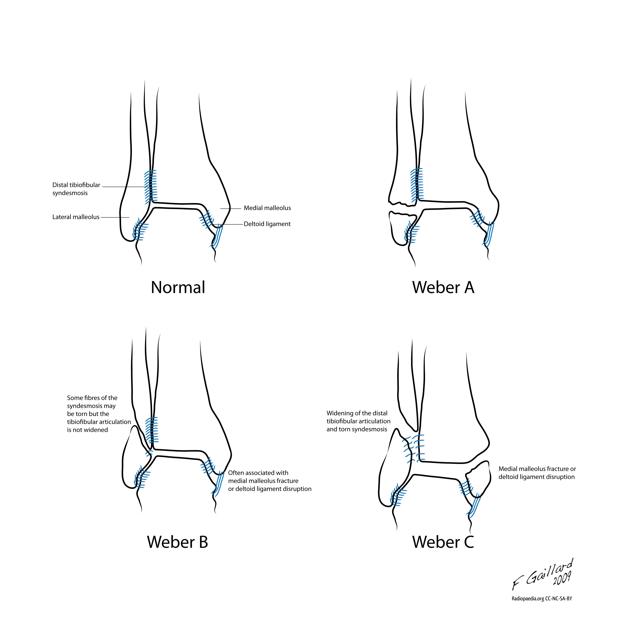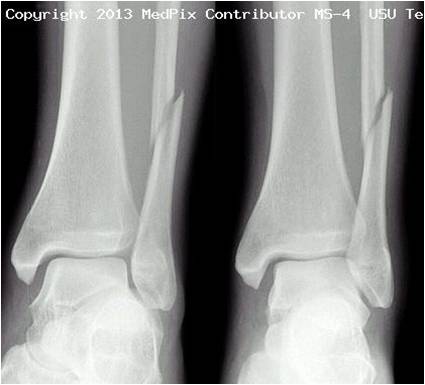Ankle fracture: Difference between revisions
Mceledon83 (talk | contribs) No edit summary |
Mceledon83 (talk | contribs) No edit summary |
||
| Line 1: | Line 1: | ||
== | ==Physical Exam== | ||
*Examine for ecchymoses, abrasions, or swelling | |||
*Note skin integrity and areas of tenderness or crepitus over ankle | |||
*Range joint passively and actively to evaluate for stability | |||
*Examine Joints above and below the ankle | *Examine Joints above and below the ankle | ||
*Perform anterior drawer test (positive exam suggests torn ATFL) | |||
*'''Always palpate proximal leg to rule-out [[Maisonneuve Fracture]] or fibulotibialis ligament tear''' | |||
**Perform a crossed-leg test to detect syndesmotic injury | |||
*Evaluate integrity of Achilles tendon (Thompson test) | *Evaluate integrity of Achilles tendon (Thompson test) | ||
* | *Palpate midfoot and base of 5th metatarsal for tenderness | ||
== | ==Diagnosis== | ||
*[[Ottawa Ankle Rules]] | *[[Ottawa Ankle Rules]] | ||
*3 views: | *3 views: | ||
Revision as of 22:51, 20 August 2013
Physical Exam
- Examine for ecchymoses, abrasions, or swelling
- Note skin integrity and areas of tenderness or crepitus over ankle
- Range joint passively and actively to evaluate for stability
- Examine Joints above and below the ankle
- Perform anterior drawer test (positive exam suggests torn ATFL)
- Always palpate proximal leg to rule-out Maisonneuve Fracture or fibulotibialis ligament tear
- Perform a crossed-leg test to detect syndesmotic injury
- Evaluate integrity of Achilles tendon (Thompson test)
- Palpate midfoot and base of 5th metatarsal for tenderness
Diagnosis
- Ottawa Ankle Rules
- 3 views:
- AP
- Best for isolated lateral and medial malleolar fractures
- Oblique (mortise)
- Best for evaluating for unstable fracture or soft tissue injury
- At a point 1cm proximal to tibial plafond space between tib/fib should be ≤6cm
- Lateral
- Best for posterior malleolar fractures
- AP
Classification (Danis-Weber System)
System based on level of the fibular fx
Type A (supination-adduction injury)
- Fibular Fx at or below level of ankle joint (talar mortise) without syndesmotic involvement
- Typically stable
- Deltoid ligament usually intact, medial malleolus usually fx
- A1: isolated
- A2: medial malleolus fx
- A3: posteromedial fx
Type B (supination-external rotation injury)
- Fibular Fx at level of ankle joint (talar mortise) w/ partial syndesmotic ligament injury
- Stability dictated by integrity of tibiofibular syndesmosis (no widening of distal tibiofibular articulation)
- Deltoid ligament may be torn, medial malleolus usually fx
- B1: isolated
- B2: medial lesion (either malleolus or ligament)
- B3: medial lesion and fx of posterolateral tibia
Type C (pronation-eversion injury)
- Fibular Fx above level of ankle joint (talar mortise) w/ complete syndesmotic disruption
- Unstable (widened distal tibiofibular articulation) and require surgical correction
- Deltoid ligament torn, medial malleolus fx
- C1: simple diaphyseal fibular fracture
- C2: complex diaphyseal fibular fracture
- C3: proximal fracture
Management
- Lateral malleolar Fx (isolated)
- Treat like severe ankle sprain unless unstable:
- Displacement >2mm
- Medial fx
- Widening of medial clear space (deltoid injury)
- Treat like severe ankle sprain unless unstable:
- Medial or posterior malleolar Fx
- Must rule-out other injuries
- If non-displaced, isolated:
- Short-Leg Posterior Splint (ankle at 90')
- Non-weight bearing
- Refer in 5-7d
- Lateral malleolar fx with deltoid injury OR bimalleolar OR trimalleolar fx
- Short-Leg Posterior Splint (ankle at 90o)
- Immediate consultation in ED
X-rays
See Also
- Ankle Sprain
- Ankle Fracture (Peds)
- [[Ottowa Ankle Rules]
- Maisonneuve Fracture
- Pilon Fracture
- Fracture (Main)
- Splinting
Source
- Tintinalli, Radiopaedia.org (Images by Dr. Frank Gaillard), Medpix Radiology Teaching Files (Images by Dr. Timothy Sanders)








